
Welcome to instalment two of our brief mini-series of weekly instalments focussed on the Aces of the Deep- the Top Ten U-boat Commanders of World War 2.
This second instalment is focussed on one of Germany's most famous Aces of the Deep- Günther Prien.
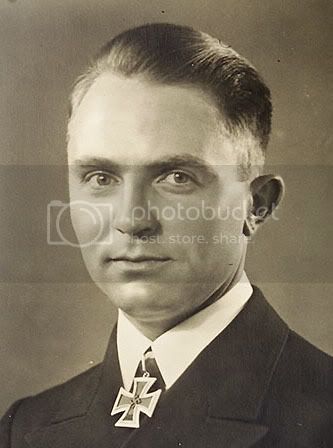
Image courtesy of Wikipedia
Günther Prien was born on the 16th of January 1908 in the town of Osterfeld in the state of Thuringia in central Germany, the son of a judge and the eldest of three children.
Early Life
Günther Prien early childhood was spent in the northern port city of Lübeck, but this was to change after his parents marriage ended. The young Günther, his mother, along with his younger sister and brother Liselotte and Hans-Joachim moved to the Saxon city of Leipzig.
Life in Leipzig was far from easy, with Frau Prien making ends meet by buying and selling Erzgebirge lace.
School did not excite the young man for his primary dream was to sail the high seas like his hero the Portuguese seafarer Vasco de Gama whose picture sat above his bed.
In 1923 Prien made the first concerted move towards a seafaring career at the age of fifteen years old. His mother gave into his desire to be a seafarer and allowed him to enrol for a three month course at the Seaman's College (Deutsche Seemannsschule) at Finkenwärder near Hamburg - dubbed the "matelot sausage machine".
As you would expect the training at Finkenwärder under Captain Oelkers was tough and discipline was strict – however after the three months Prien and all of the others who had enrolled along with him passed the examination. Without any money to afford the fare for the journey home, Prien remained at Finkenwärder. This was to prove to be a lucky break because he was offered a place on the sailing ship Hamburg. After he had enquired about his wages, he was laughed at by Oelkers, who also went on to say that as the Hamburg was also a training vessel, he would have to pay a further thirty Reichsmarks. He left disappointed, thinking perhaps that the opportunity had gone; however later that evening the Captain summoned him back to his office again, and informed the young Prien that the fees had been waived. After yet more cheeky questions about wages, Prien was provided with an outline of the pay structure - 'rising in small increments from zero Marks'
Prien soon found himself in the thick of things on board the Hamburg. During his first week he managed to get on the wrong side of one of the senior matelots, and was quickly made to understand how the hierarchy on board a merchant ship worked. His first assignment was to scrub up the latrine, popularly known as the "parliament", with only a supply of salt and a bucket of hot water. As the months passed he found himself engaged in a wide variety of roles, including cabin boy, deckhand and even a short stint as a replacement cook. He excelled in all tasks, apart from a (in hindsight, at least) comical attempt to change the colour of white cabbage using red lead dye that was to lead to both a stomach upset for his crewmates and the ending of his short career in the kitchens.
By serving on the Hamburg Prien had also fulfilled his dream to see beyond his homeland, with his journeys taking him to the Azores, Great Britain and across the Atlantic to America.
In 1925 however disaster struck, when the Hamburg found itself caught up in a violent storm off the coast of Ireland and the ship was flung towards the coastline. Prien and a number of his colleagues then found themselves involved in what amounted to face-to-face combat with a small army of rats. The local lifeboat was to arrive not a moment too soon. All of the Hamburg's crew were ferried to Dublin, and the following morning they attempted to salvage what they could from their stricken vessel. All attempts to get the ship serviceable again proved fruitless, and after six weeks the ship was finally written off as a wreck. The crew now found themselves being shipped back to Germany as third-class passengers - as sailors without a ship.
Prien's tale of woe did not end there; back in Hamburg at the company office expecting some sort of wage packet, he was duly informed by the clerk that he owed the ship's book five marks and seventy pfennigs for supplies he had drawn on board during his period of service.
Prien found himself back in Hamburg having landed a job as an Offiziersanwärter on board the South America-bound freighter Pfalzburg, an ugly vessel compared the three-masted full-rigger Hamburg.
All of this hardship was worth it however, as by early 1929 the twenty-one year old Prien soon found himself as the Fourth Officer on the passenger vessel San Francisco, his master's and wireless operator's certificates both safely in his pocket. As well as gaining a wealth of seafaring knowledge and expertise, Prien had also been able to acquaint himself with many places around the world, imbibing a wealth of knowledge and experience far removed from his early life.
Extract from www.u47.org
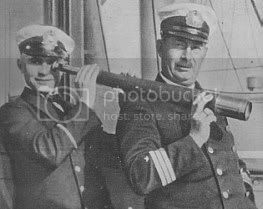
Young Prien on the San Francisco.
Image courtesy of www.u47.org
On 11 March 1929, the San Francisco set out from Hamburg on a cold, grey evening en route to America. Not long into the journey, there followed a collision with another vessel, which Prien found out to be the steamer Karlsruhe. Following an outburst from an irate passenger, the Fourth Officer - Prien - was to effectively become the scapegoat. The damage was minor and had been calculated at 35,000 Reichsmarks, and the vessel was able to continue with its voyage. That no great harm was done was little consolation to the young Prien, who spent the remainder of the voyage brooding over the thought that everything he had worked for might come to nothing.
The time soon came when Prien, the Captain and First Officer were summoned to attend the Marine Court - the Seeamt - in the port of Bremerhaven. After the three men had been given a thorough grilling by the Court Commissioner, the mood was not great, with everyone still unsure as to which way the verdict would go. After being called back into the Court, the verdict was finally presented: it was the poor weather that had been the reason for the collision, and everyone else was absolved of blame. A great weight lifted from his shoulders, Prien decided there and then that he was going to double his efforts to obtain the captain's certification. In January 1932, almost three years after the collision with the Karlsruhe, Prien had achieved his goal. One would have thought that a great Merchant career lay ahead, but this was not to be the case.
Extract from www.u47.org
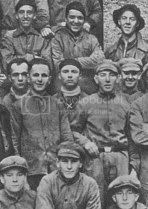
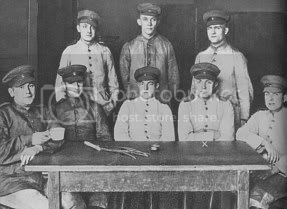
Prien doing volunteer work he is marked with an “x”
Images courtesy of www.u47.org
1932 was to witness a number of changes in Prien's life, not least of all his merchant career. The Merchant Marine found itself having to make substantial cutbacks. All of this meant that no sooner had he received his captain's certification, Prien found himself unemployed. Deciding to stay on in Hamburg with the hope of finding a suitable job, the unemployed Merchant marine skipper found himself living off his savings, with much of his spare time spent reminiscing with Harry Stwer - his former bosun on board the Hamburg who now owned a bar on the Davidstrasse. After a brief flirtation with the thought of being an author by attempting to undertake the translation of Robert L. Gandt's China Clipper, the twenty-three year old Prien had decided to return home to Leipzig.
Prien's desperate attempts to secure a job in Leipzig proved to be no better than it had been back in Hamburg, and he soon found himself having to go to the local Mietskaserne, the equivalent of the unemployment benefits office. A total feeling of despair led Prien to join the up and coming National Socialist party - in May 1932 be became member number 1,128,487 So
1932 dragged on, and saw the unemployed Merchant Marine captain end up as a labourer in a succession of work-gangs in the Vogtland. Even there he made a good reputation for himself, and had been lined up as a potential leader. But Prien had always been a seaman; being a leader on a building site was not where he wanted to be. In late 1932 his life and career was to take another turn when heard the news that the Reichsmarine, the successor to the wartime Imperial Navy, had opened its doors to officers from the Merchant Marine. Prien headed off to the Baltic port of Stralsund to volunteer.
Extract from www.u47.org
By the end of January 1933, Günther Prien was back in uniform again, having been admitted to the Reichsmarine at the rank of ordinary seaman.
U-Boat Training
After a period of service on the light cruiser Königsberg as an officer cadet, Prien obtained his full commission, and was transferred in October 1935 to the U-boat force (Ubootwaffe) at the rank of Leutnant zur See in what had now become the Kriegsmarine. He was almost immediately placed on the U-boat training course, along with a number of others who were also to go on to be some of the most successful U-boat commanders, among them Joachim Schepke and Herbert Schultze.
The training department, at that stage officially titled the school of anti-submarine warfare (Unterseebootsabwehrschule, or UAS), had on the 6th of June 1935 been placed under the command of the then Kapitän zur See Karl Dönitz. The boats used were type IIA and IIBs. For his training, Prien found himself on the U-3, one of the new Type IIAs.
Extract from www.u47.org
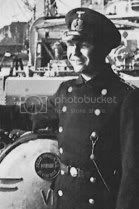
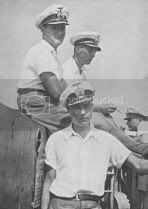
Gunther Prein in training
Images courtesy of www.u47.org
The training that U-boat crews had to undergo was thorough with a strict, well-organized, and intense programme. It was the thoroughness of this training programme that was to produce the highly skilled commanders and crews that only a few years later were to take to the seas and strike fear into the opposition. The thoroughness of the training was exemplified by the number of practice attacks a trainee crew had to make before even being permitted to fire a live torpedo - a staggering total of 132 maneuvers, 66 of which were submerged and 66 while surfaced, using shots of compressed air known to the crews as "water slugs".
Within two years of beginning his U-boat training Günther Prien was promoted, attaining the rank of Oberleutnant zur See on New Year's Day 1937. During the following year Prien was stationed on the experimental Type IA boat U-26 as a watch officer under Kapitänleutnant
Werner Hartmann, picking up valuable "real time" experience patrolling in Spanish waters during the Spanish Civil War. Hartmann was a particular admirer of the young officer, who in addition to being meticulous, thoroughgoing and dedicated to his profession was also a highly personable individual who could keep eager listeners enthralled with a vast array of stories about his ventures around the world as a merchant seaman.
Sometime in 1939 before the start of what was to become the Second World War, Prien married his fiancée Ingeborg. According to what Prien "said" in the ghost-written autobiography Mein Weg nach Scapa Flow, he had met his future wife after supposedly mistaking her for someone he had met sometime earlier in the city of Plauen in the Vogtland. However, in various interviews after the war Prien's widow discounted the account in Mein Weg nach Scapa Flow as
pure fantasy. A happy married life was not going to last long however - as war was just around the corner.
Extract from www.u47.org
On 17 December 1938 at the rank of Oberleutnant zur See, Prien was given command of the Type VIIB U-47, the most junior officer to be given command of one of these newer, more advanced vessels. This was not without justification: Prien had been highly rated by his superiors, making his mark during the Atlantic "war games" of May 1939 where he had been the most aggressive and achieved the best results. On the1st of March 1939 he was promoted to Kapitänleutnant.
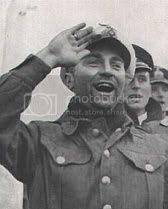
Image courtesy of www.u-boataces.com
The War
When war broke out in September Kapitänleutnant Prien was to make his mark as the first U-boat commander to gain a successful sanctioned kill* on his first Atlantic patrol, with the sinking of the British steam ship Bosnia on the 5th of September 1939, a mere two days after the opening of hostilities. Prien conducted the attack with a chivalry that was often shown by the U-boat aces: after the British vessel had refused to heed verbal warnings, it was attacked with deck gunfire. Not before having the crew of U-47 assist the Bosnia's survivors by bailing out their capsized lifeboat, Prien allowed its stricken crew to be picked up by a neutral Norwegian ship before finally sending the steamer to the bottom of the Atlantic with a torpedo. No-one was killed during this attack.
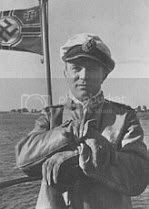
Image courtesy of www.u47.org
Prien's first skirmish was to yield a total of three victims, the sinking of the Bosnia being followed by the successful attacks on the 6th and 7th of September against the British freighters Rio Claro and Gartavon. Once again, the crews were allowed off their stricken vessels and allowed to progress in their lifeboats before U-47 delivered the coup de grce. The eventual sinking of the Gartavon was particularly eventful: after the crew had taken to the boats, the crewless freighter steamed in an arc towards U-47. After U-47 had dodged the ship, a single torpedo was fired to sink her. After the torpedo jagged off course and passed wide, the decision was made to sink it with shells from the 88mm deck gun.
U-47 safely returned to port on 15 September, and ten days afterwards Prien was awarded the Iron Cross second class.
At the very beginning of the war old codes of chivalry remained in force, and Prien stood firmly by these values and always encouraged his officers and men to do the same. During these early forays, he often invited the captain of the stricken merchantman on board the U-boat, exchanging pleasantries and assuring them that the crews would come to no harm before making sure the crews of the vessel were safely aboard their lifeboats. This approach led to the sinkings of enemy vessels without any loss of life, as was the case with the Bosnia. As the war went on however and Allied vessels started to carry arms, attitudes among U-boat crews had to change:
“From then on the war hardened with every day. The British began to arm their merchant ships and send them in convoys. We acted accordingly. Every vessel in an enemy convoy was liable to be torpedoes without warning and we worked according to the formula: Any ship in convoy to the bottom.”
(Günther Prien, Mein Weg nach Scapa Flow)
Prien's second patrol was to elevate the man from the small town in Thuringia to the status of legend. After the chief of the U-boat fleet, Karl Dönitz (himself now an Admiral), had suggested an attack on the British Northern Fleet at the base of Scapa Flow in the Orkney Islands, Prien jumped at the opportunity. In an audacious night-time raid on the "impenetrable" British base on the night of 13/14 October 1939, U-47 attacked and sunk the battleship Royal Oak before escaping back to base unscathed and accepting the adulation of his chief, Adolf Hitler and the German people.
Extract from www.u47.org
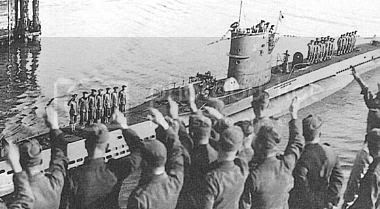
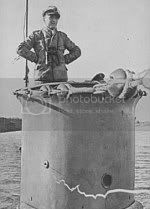
The U-47 amid cheering crowds, after returning from Scapa Flow (October 17 1939).
Images courtesy of www.u47.org
On his return to Germany, the first recognised "ace" of the war was awarded with both the Iron Cross first class and the Ritterkreuz, the latter presented by Hitler himself in Berlin on the18th of October 1939, along with the rest of the crew.
The American journalist and author William L. Shirer, present in Berlin at the time, described Prien and his crew:
“Captain Prien, commander of the submarine, came tripping into our afternoon press conference at the Propaganda Ministry this afternoon, followed by his crew - boys of eighteen, nineteen, twenty. Prien is thirty, clean-cut, cocky, a fanatical Nazi, and obviously capable. Introduced by Hitler's press chief, Dr. [Otto] Dietrich, who kept cursing the English and calling Churchill a liar, Prien told us little of how he did it. He said he had no trouble getting past the boom protecting the bay. I got the impression, though he said nothing to justify it, that he must have followed a British craft, perhaps a minesweeper, into the base. British negligence must have been something terrific”

The crew before meeting Adolf Hitler
Image courtesy of www.u47.org
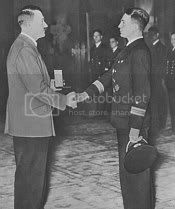
Hitler personally decorates Gunther Prien for sinking of the Royal Oak, in Scapa Flow.
Image courtesy of www.u47.org
The reception Prien and his crew received in Berlin was rapturous; the crowds were out in force to greet and cheer them in the streets, and an impromptu speech by Prien during a celebratory show at Berlin's Wintergarten theatre was broadcast on national radio - where it was also announced that the public had provided 50,000 Reichsmarks in donations. Friends and family of the victorious crew had been transported to Berlin for this evening of patriotic festivities, including Prien's wife Ingeborg and the proud mother of his II.WO Amelung von Varendorff. Well-wishers and autograph hunters young and old lined the streets in anticipation of meeting their hero; one lucky young fan was the eight year old Norbert Kelling, who happened to be at the show that evening:
“On the evening of October 18, 1939, I accompanied my parents to the Wintergarten. During the show, a rumour spread among the audience that Kapitänleutnant Prien and his crew would appear. The main door opened and the band began to play. The audience rose from their seats as Prien entered, accompanied by his wife as well as his crew. They were led through the cheering audience to their seats in the front rows. The wireless programme 'Wunschkonzert' was switched to the microphones of the show. During the interval, Prien was besieged by people asking for autographs. My mother succeeded in getting one for me and I proudly showed this to my classmates at school. The enthusiasm for Prien in Germany can only be compared with Britain's love for Admiral Nelson.
I always kept the postcard with his autograph in my small suitcase with my favourite toys to take with me into the shelter during the bombing raids on Berlin in the years which followed. So
it is today I still possess the autograph in spite of being bombed out and evacuated from Berlin”
Extract from www.u47.org
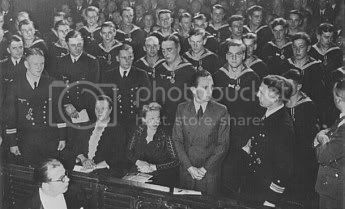
Images courtesy of www.u47.org
A photo of that evening at the Wintergarten with the crew and Goebbels present.
Following the events at Scapa, Prien's reputation was boosted further by the propaganda machine, which sought to make capital out of his success.
In 1940 the inevitable book chronicling the mission, Mein Weg nach Scapa Flow ("My path to Scapa Flow"), was released to the public. Supposedly written by Prien, Mein Weg nach Scapa Flow was in fact written by an author called Paul Weymar, who had been commissioned by the publisher Deutscher Verlag to ghost-write an autobiography for the skipper of U-47. The lavishly-illustrated work took the rudimentary facts and blended them into an almost work of fiction.
Prien was not only seen sinking the Royal Oak under cover of darkness, but making good his escape in dramatic fashion while being pursued by a pack of enemy destroyers bent on his destruction.
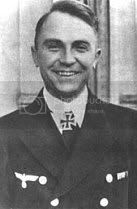
Image courtesy of www.u-boataces.com
Drafted in a mere six weeks, Weymar's manuscript was littered with inaccuracies and written in a style clearly intended to aid the recruitment of young men into the navy; the primary purpose was to provide the German people with a heroic and morale-boosting story rather than a record of the historical course of events. Further alterations by both the German High Command and the Propaganda Ministry only served to add more errors to the text.
Prien quickly became a household name, and the German people - as well as the propaganda ministry - loved it.
The "Bull of Scapa Flow" himself was to take a slightly different and somewhat more reserved view however, stating openly that he was "an officer, not a film star". His widow Ingeborg was said to have stated that Günther was "very angry" when he received the manuscript, and had "kept crossing things out". The changes her husband made were, she believed, never incorporated into the published book.
The ghost-writer Weymar himself was unhappy with his association with the book, going so far as to state his refusal to be involved in anything to do with "Prien's book" ten years after the war in 1955.
Fresh from the receipt of his Ritterkreuz, Germany's most famous "Kaleun" and his crew set off once again for the familiar waters of the North Atlantic, putting out to sea on 16 November. On what was to be a gruelling patrol lasting just over a month, U-47 sunk three enemy vessels between 5 and 7 December - the British freighter Navasota, the Norwegian tanker M/S Britta, and the Netherlands-based Tajandoen.
Earlier in this patrol on the 28th of November, Prien had attacked the British "London" class heavy cruiser Norfolk, following a signal from U-35 commanded by Kapitänleutnant Werner Lott. Prien carefully closed in on the Norfolk, firing a single torpedo which apparently struck the British vessel. The respective sides offered different views on what had happened: while the German propaganda ministry credited Prien with the Norfolk's destruction, the British claimed that no damage had been done. Prien returned to Kiel on the 18th of December, once again to a hero's welcome.
1940 was to be an interesting year for Kapitänleutnant Prien and his crew, mainly due to the constant problems he and other U-boat skippers were experiencing with their torpedoes, in what soon became known as the Torpedo Crisis. Things began poorly, with U-47's first patrol of the year, its fourth in all, yielding only one victim during its nineteen days at sea, the Danish steamer Britta. Days went by with not an enemy vessel to be seen, with the boredom only being broken by the periods in which U-47 found itself dodging enemy destroyers and their deadly depth charges. Having spent nineteen unproductive days at sea, Prien returned to base
disappointed.
As far as the torpedo problem was concerned, things were to come to a head during the next (fifth) patrol during the Norwegian campaign, codenamed Operation Weserübung, where Prien and his colleagues were more often than not left watching salvo after salvo either explode prematurely or trickle harmlessly away from their intended targets. The misery felt by Prien and his crew was broken only by the good news that Prien's wife Ingeborg had given birth to a healthy baby girl on 7 April; with a dose of nautical humour, Dönitz had telegraphed Prien, announcing the arrival of a new "U-boat without a periscope" ("Ein U-boote ohne Sehrohr ist heute angekomen").
Extract from www.u47.org
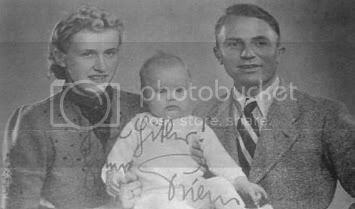
Prien with his wife and young daughter.
Image courtesy of www.u47.org
What was probably the most significant "incident" concerning the torpedoes took place late in the evening on the 16th of April at the Bydgenfjord near the port of Narvik; after having launched four torpedoes at short range at what was effectively a wall of stationary vessels, Prien witnessed all four devices fail to achieve any results. Undeterred, he reloaded the four bow tubes and ran in for a second attack, with the results almost identical. Worse still, one of the four "eels" strayed away and exploded harmlessly against the base of a cliff. If this were not bad enough, the U-boat ran aground on an unchartered sand bar and damaged an engine in freeing itself, a situation that could well have ended in disaster had the enemy vessels - among them two battle cruisers - been alerted to U-47's presence. In order to free the boat from the sand bank, a number of the crew found themselves having to charge up and down the length of the vessel to create enough movement to engineer an escape.
Extract from www.u47.org
The whirring propeller churned a wake of froth astern. Still the U boat stuck fast.
“Tramp-tramp to starboard - back again - and again! Doggedly the men pounded backwards and forwards on the exposed casing. Very gradually the boat began to rock. With each new effort the propellers thrashed deep whirlpools in the limpid fjord water astern, for'ard on either side of the boat the compressed air seethed and bubbled. At last, after minutes, with a scrunching groan and a heave the boat sprang free”
- Wolfgang Frank, Enemy Submarine
U-47 finally returned to port on the 6th of July, claiming a figure of 66,587 tons which was proudly dispalyed on both sides of the conning tower fas the vessel rolled into port. The ten tonnage pennant flags fluttered equally proudly from the attack periscope. While the conning tower indicated a total of 66,587 tons, the total sum of all the figures on the ten pennant flags was 66,597 - which meant that either one of the pennants was wrong or there was a poor mathematician amongst the crew.
After spending the best part of two months undergoing rest and refit, U-47 put out to sea for its seventh patrol at the end of August, and was to play a significant part in what was yet another killing spree for the U-boat fleet. Over the course of this thirty-one day patrol, Prien's boat sunk seven enemy vessels for 34,973 tons, beginning with the Belgian cargo transport Ville de Mons sunk by torpedo on the 2 nd of September and the British steamer Titan.
This was the prelude to what was to be a successful period for Prien, who made his way to the slow convoy SC-2 by the 6th of September, alongside the U-65 commanded by Kapitänleutlant Hans-Gerrit von Stockhausen. Early on the morning of the 7th, Prien launched his attack, striking three vessels - the British freighters Neptunian and José de Larrinaga and the Norwegian steamer D/S Gro - in just under one and a half hours. This burst was followed by the sinking of the Greek freighter Possidon two days later.
After its success against convoy SC-2, U-47 - which had only a single torpedo remaining - was assigned as weather boat, a mundane but essential task. On the 20th of September, it sighted the forty-ship convoy HX-72, and quickly called in a team of eight U-boats. Its job done, U-47 was ordered back to port. Not to be outdone however, Prien joined in the attack, using his last torpedo against the British freighter Elmbank before turning the 88mm deck gun on the stricken vessel, which was eventually finished off by one of the other famous U-boats, U-99 –
commanded by Kapitänleutnant Otto Kretschmer
Extract from www.u47.org
U-47 returned to dock at the French base of Lorient on the 25th of September after yet another highly productive mission.
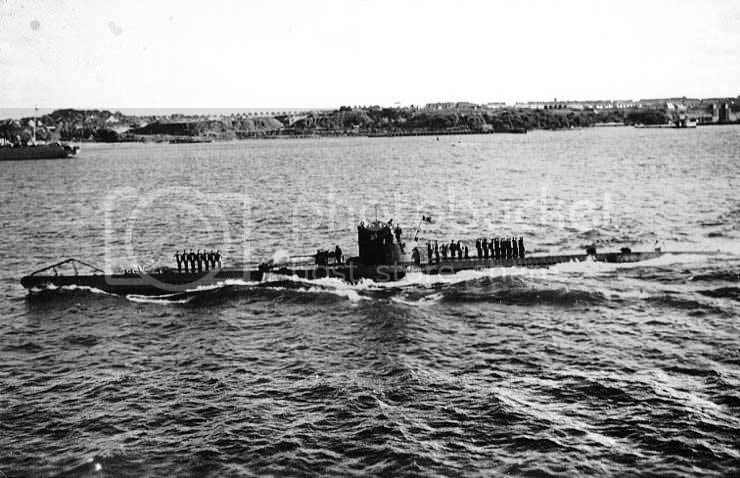
Image courtesy of www.ubootwaffe.net/
U-47 photographed from the battlecruiser Scharnhorst, October 1939.
Prien and his crew had a fortnight's leave, and on the 14th of October were once more back in the North Atlantic. On the 19th of October, Prien sighted the convoy HX-79, en route from Liverpool to Halifax, Nova Scotia. He was soon joined by four other boats, who then proceeded to join Prien in what was a serious attack on the enemy convoy.
Prien's first success came on the 19th of October, when a torpedo hit the Dutch steam freighter Bilderdijk. This was followed by an attack on the British tanker Shirak and the motor freighter Wandby. The Wandby was left mortally wounded, eventually sinking two days later. This furious all-out assault continued into the small hours of the following day, with U-47 turning on three British vessels in the space of two hours: the freighters La Estancia and Whitford Point, and the tanker Athelmonarch. While thetanker was able to escape further punishment, the two freighters were quickly sunk.
Fresh out of torpedoes, U-47 was ordered back to port, arriving on the 23rd of October. The boat had been at sea for a mere ten days, by far the shortest of its combat patrols up to this point. Although Prien had claimed four enemy ships for a total of 22,014 tons, the propagandists back in Germany had credited him with eight ships for 50,500 tons, which - according to the propagandists, at least - took him over the magical 200,000 ton figure. This news made its way all the way to Adolf Hitler, who sent a telegram congratulating Prien on reaching this "milestone". After the successful assault on convoy HX-79, Prien returned to Germany to collect the Oakleaves to his Knight's Cross – at that point in the war he was the fifth to receive this award, and the first from the Kriegsmarine.
Extract from www.u47.org
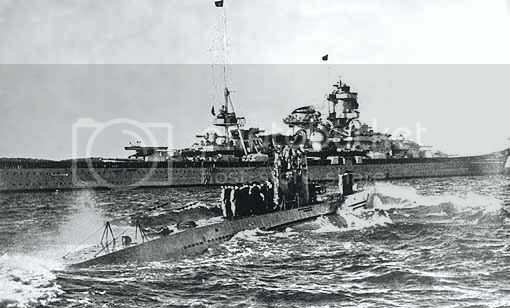
In this famous photo, U-47 receives a salute from the battlecruiser Scharnhorst after returning from sinking the British battleship HMS Royal Oak. October 14, 1939.
Image courtesy of www.u-boataces.com
On the 3rd of November 1940, just over a year after his success at Scapa Flow, the Kriegsmarine's newest Oakleaves recipient once again departed for battle. U-47 also had on board a journalist, Wolfgang Frank - whose job it was to provide an inside view of life on a submarine for enthusiastic readers back home in Germany - a role similar to that of Lothar-Günther Buchheim, the author of the classic novel Das Boot.
Having got to know the famous U-boat commander, Wolfgang Frank himself confirmed this view, going on to say that Prien found much of the adulation mildly amusing.
In 1942 Frank went on to write a book of his experiences on board U-47, entitled Prien greift an - "Prien Attacks", which was later published in English with the title Enemy Submarine.
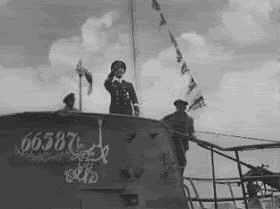
The Bull of Scapa Flow - Gunther Prien in U-47 seen here departing from Kiel harbor.
Image courtesy of www.u-boataces.com
Within a week of departing from Lorient U-47 had located what it thought was its first target - the Portuguese steam freighter Gonçalo Velho, which was damaged by deck gunfire. Realising that the vessel was a neutral, Prien let it carry on its way. This brief foray was a prelude to a long period of inactivity, which lasted almost a month.
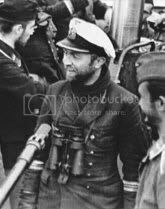
Image courtesy of www.u-boataces.com
The dry spell finally came to an end on the 2nd of December when they came across another Liverpool-Halifax convoy, HX-90. Accompanied by six other boats, U-47 laid into the convoy, but the results were, by Prien's high standards at least, fairly ordinary. A successful strike was made against the Belgian cargo vessel Ville d'Arlon and a hit was recorded on the British motor tanker Conch (which was later hit by the Type VIIC U-95 commanded by Gerd Schreiber and then finished off by Kretschmer's U-99), but apart from this the patrol was a disappointment, not only to Prien and the crew of U-47 but also to the visiting journalist.
Extract from www.u47.org
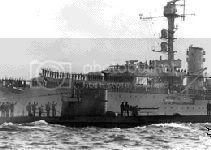
U-47 commanded by U-boat ace Gunther Prien, receiving a salute from the German Cruiser Emden.
Image courtesy of www.u-boat.net/
U-47 finally rolled into dock on the 6th of December, and the bad mood of the crew following this dismal ninth patrol was no doubt lessened by the promise of home leave over Christmas and an overhaul of the submarine. Although still seen by the propagandists as the original U-boat "ace", Prien was to see his long-held position of "king of the aces" taken by Otto Kretschmer, whose U-99 was (mistakenly) credited for over two-hundred and fifty thousand tons.
In a story so typical of some of Germany's finest soldiers during the Second World War, Admiral Dönitz tried to persuade Prien to transfer to a training unit, but he refused, preferring instead to stay with his crew and boat.
Refreshed a rest and with his boat refitted, Prien set out on his and U-47's tenth patrol on the 20th of February 1941. Making its way to the west coast of Ireland, U-47 encountered the outbound convoy OB-290 on the 25th of February. Following Prien's report, Dönitz ordered for reinforcements, but when these failed to arrive in time the skipper of U-47 decided to take on the convoy alone. His first victim was the Belgian freighter Kosongo, which was struck by a torpedo just after midnight on the 26th. This was quickly followed by a hit on the British tanker Diala which only damaged the 8,100 ton vessel. Within the hour, Prien had reloaded and had set about claiming his second and third victims of the day, the Swedish freighter M/S Rydboholm and the Norwegian freighter Borglund.
U--47's key role in the attack on Convoy OB-290 did not stop there: acting as a beacon, the boat successfully guided the dangerous Condor bombers towards the procession of slow-moving vessels. In a concerted aerial attack, a squadron of six Condors sunk seven of the merchantmen and damaged an eighth. On the 28th of February U-47 came upon a straggler from the stricken convoy, the British steamer Holmelea, which was quickly despatched with 88mm gunfire. The steamer was U-47's fourth victim of its tenth patrol, and the thirtieth in all since the beginning of the war. Things were to get better on the following day when Prien received the news that he had been promoted to the rank of Korvettenkapitän.
Extract from www.u47.org
U-47's was to wait over a week for its next encounter, when it came upon the 20,638-ton British whaler Terje Viken, part of outbound convoy OB-293 on the 7th of March. Two torpedoes were fired at the whaler, both registering successful hits. Not long after launching this attack, Prien found himself among a pack of at least four enemy destroyers, among which was the Wolverine, commanded by Commander James Rowland.
No signal was received from U-47 from the time it had run into the British attack vessels. In what was to mark the beginning of a black period for the U-boat fleet, Prien was presumed missing after he had failed to report his position to BdU.
The authorities back in Germany were shell-shocked. A mere ten days later on the 17th of March, two of Prien's fellow aces were also to disappear from the scene: Joachim Schepke and U-100 were lost , while U-99 commander Otto Kretschmer and his crew were captured and taken prisoner by the British. Admiral Dönitz was heavily shaken by the loss of three of his finest, and propaganda minister Josef Goebbels wanted to keep the losses quiet for fear of seeing a massive drop in morale.
Aware of the situation, the Allies dropped a number of leaflets over Germany, with the following:
“Schepke - Kretschmer - Prien. What has become of these three officers, the most famous German U-boat commanders, the only ones on whom Hitler has bestowed the Oak Leaves Cluster to the Knight's Cross? Schepke is dead. German High Command had to admit it. Kretschmer is captured. German High Command had to admit it. And Prien? Who has heard anything of Prien recently? What does German High Command have to say about Prien? Where is Prien?”
The decision to keep the loss of the Kriegsmarine's most popular U-boat commander away from the German public may have done more harm than good; questions were being asked, and following the dropping of the "Wo ist Prien" leaflet the German propaganda machine had probably got itself into a fix it could very easily have avoided. The lack of news about Prien generated all sorts of fantastic gossip - including once rather incredible story about his turning anti-Nazi and ending up behind the wire of a concentration camp.
Like many other aces during the war, the destruction of U-47 has for a long time been a subject of debate among naval historians. Of all the case scenarios that have been postulated, the most likely is that the U-boat had been subjected to depth-charge attack by both the Wolverine and another destroyer, Verity, although no concrete evidence was or has ever been produced to confirm this. Other equally feasible explanations include crew error, structural failure or that the submarine might have been hit by a stray torpedo, possibly one of its own. Of course, this is all pointless in the clear light of war. What is clear is that Korvettenkapitän Prien failed to report to headquarters after March 7th, and that U-47 and its crew were never to be seen again.
The loss of Günther Prien and his fellow U-boat aces during the course of March 1941 precipitated the beginning of the end for the German U-boat fleet; the issue of morale had been set at such a high premium that Prien's death was not even officially announced until 23 May 1941 - over two months after U-47 had been reported missing.
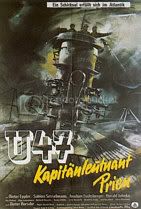
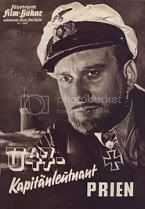
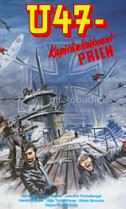
Images courtesy of www.u47.org
A movie based on the life and wartime career of Günther Prien, U-47 - Kapitänleutnant Prien, directed by Harald Reinl and starring Dieter Eppler in the lead role, was released by ARCA Film Produktion GmbH in Germany in 1958. While being loosely based on the life of the commander of U-47 and his crew, it has a few injections of fiction to complete the plot. Nevertheless, the movie sticks close to reality when describing the life of a submariner and what
it was like fighting the war from the depths of the North Atlantic.
After his untimely death at sea in March 1941, a street in the Austrian border town of Braunau-am-Inn - Nazi leader Adolf Hitler's place of birth - was named after Günther Prien. Günther Prien-Strasse was located in the district of Braunau-Laab, and was renamed after the war to Adolf Wenger-Strasse. A neighbouring street, now called Franz Stelzhamer-Strasse, was also named after another famed U-47 crewman, Prien's first watch officer Engelbert Endrass, who later went on to command both U-46 and the Type VIIC U-567 before his death on the 21st of December 1941.
Extract from www.u47.org
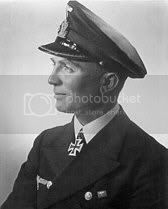
Image courtesy of www.u-boat.net/
Outlined below are the very impressive statistics of Gunther Priens outstanding career achievements as an “Ace of the Deep”.
Ranks attained
1 March, 1933 Fähnrich zur See
1 January, 1935 Oberfähnrich zur See
1 April, 1935 Leutnant zur See
1 January, 1937 Oberleutnant zur See
1 February, 1939 Kapitänleutnant
1 March, 1941 Korvettenkapitän
Statistical information courtesy of www.u-boat.net/
Decorations received
25 September, 1939 Iron Cross 2nd Class
17 October, 1939 Iron Cross 1st Class
18 October, 1939 Knights Cross
20 October, 1940 Knights Cross with Oak Leaves
Statistical information courtesy of www.u-boat.net/
Patrol summary
Total of 10 patrols and 238 days at sea
U-boat U-47 Departed on the 19th of August, 1939 from Kiel and arrived at Kiel on the 15th of September, 1939. A total patrol of 28 days.
U-boat U-47 Departed on the 8th October, 1939 from Kiel and arrived at Wilhelmshaven on the 17th of October, 1939 a total patrol of 10 days.
U-boat U-47 Departed on the 20th of October, 1939 from Wilhelmshaven and arrived at Kiel on the 21st of October, 1939 A total patrol of 2 days.
U-boat U-47 Departed on the 16th of November, 1939 from Kiel and arrived at Kiel on the 18th of December, 1939 A total patrol of 33 days.
U-boat U-47 Departed on the 29th of February, 1940 from Kiel and arrived at Wilhelmshaven on the 5th of March, 1940 A total patrol of 6 days.
U-boat U-47 Departed on the 11th March, 1940 from Wilhelmshaven and arrived at Wilhelmshaven on the 29th of March, 1940 A total patrol of 19 days.
U-boat U-47 Departed on the 3rd April, 1940 from Wilhelmshaven and arrived at Kiel on the 26th of Apr, 1940 A total patrol of 24 days.
U-boat U-47 Departed on the 3rd of June, 1940 from Kiel and arrived at Kiel 6th of July, 1940 on the A total patrol of 34 days.
U-boat U-47 Departed on the 27th of August, 1940 from Kiel and arrived at Lorient on the 25th of September, 1940 A total patrol of 34 days.
U-boat U-47 Departed on the 14th of October, 1940 from Lorient and arrived at Lorient on the 23rd of October, 1940 A total patrol of 10 days.
U-boat U-47 Departed on the 3rd of November, 1940 from Lorient and arrived at Lorient on the 6th of December, 1940 A total patrol of 34 days.
U-boat U-47 Departed on the 20th of February, 1941 from Lorient and sunk approximately 7th March, 1941. A total patrol of 16 days.
Statistical information courtesy of www.u-boat.net/
Vessels hit by Gunther Prien
5 September 1939 Bosnia
6 September, 1939 Rio Claro
7 September, 1939 Gartavon
14 October, 1939 HMS Royal Oak
5 December, 1939 Navasota
6 December, 1939 Britta
7 December, 1939 Tajandoen
25 March, 1940 Britta
14 June, 1940 Balmoralwood
21 June, 1940 San Fernando
24 June, 1940 Cathrine
27 June, 1940 Lenda
27 June, 1940 Leticia
29 June, 1940 Empire Toucan
30 June, 1940 Georgios Kyriakides
2 July, 1940 Arandora Star
2 September, 1940 Ville de Mons
4 September, 1940 Titan
7 September, 1940 Gro
7 September, 1940 José de Larrinaga
7 September, 1940 Neptunian
9 September, 1940 Possidon
21 September, 1940 Elmbank damaged
19 October, 1940 Shirak damaged
19 October, 1940 Uganda
19 October, 1940 Wandby
20 October, 1940 Athelmonarch damaged
20 October, 1940 La Estancia
20 October, 1940 Whitford Point
8 November, 1940 Gonçalo Velho damaged
2 December, 1940 Conch damaged
2 December, 1940 Dunsley damaged
2 December, 1940 Ville d´Arlon
26 February, 1941 Borgland
26 February, 1941 Diala damaged
26 February, 1941 Kasongo
26 February, 1941 Rydboholm
28 February, 1941 Holmelea
Statistical information courtesy of www.u-boat.net/
My sincere apologies for the delay in this instalment as I simply underestimated the time involved in compiling this instalment..
Look out for next week’s instalment as we focus on our next Ace of the Deep.
Cheers
Sean
Footnote
In compiling each instalment I make reference to a number of established reputable sources both web and reference books.
It is acknowledged that a part or portion of the above information may have been sourced from the following sources and credit is duly acknowledged:
Bibliography – websites
www.u47.org
Wikipedia
www.u-boat.net/
u-boat waffe
U-Boats at War
U-Boats in Action Squadron/Signal
www.u-boataces.com
www.historylearningsite.co.uk
www.uboatarchive.net/
www.u-boat-reich.co.uk
www.german-navy.de/kriegsmarine/ships/uboats/
www.ubootwaffe.net/
Bibliography – books
U-Boat Commander: Fortunes of War by Gunther Prien
U-Boats Destroyed: German Submarine Losses in the World Wars by Paul Kemp
Dönitz and the Wolf Packs by Bernard Edwards
Wolf, U-Boat Commanders in World War II by Jordan Vause
German U-Boat Crews 1914-45 by Gordon Williamson and illustrated by Darko Pavlovic
Neither Sharks nor Wolves - The Men of Nazi Germany's U-Boat Arm 1939-1945 by Timothy P Mulligan
Teddy Suhren: Ace of Aces: Memoirs of a U-boat Rebel by Teddy Suhren
U-boat War Patrol: The Hidden Photographic Diary of U-564 by Lawrence Paterson
KRIEGSMARINE U-BOATS: 1939 - 1945 by Chris Bishop
U-Boat Ace: The Story of Wolfgang Luth by Jordan Vause
U122: The Diary of a U-boat Commander by Karl Von Schenk and Etienne
Iron Coffins: A Personal Account of the German U-Boat Battles of World War II by Herbert A. Werner
Shooting the War: The Memoir and Photographs of a U-Boat Officer in World War II by Otto Giese and James E. Wise
U-Boats: The Illustrated History of the Raiders of the Deep by David Miller
To the Last Salute: Memories of an Austrian U-Boat Commander by Georg von Trapp and Elizabeth M. Campbell
Wolf Pack: The Story of the U-Boat in World War II (General Military) by Gordon Williamson
The Longest Patrol: A U-Boat Gunner's War by Gregory L. Owen
The U-Boat: The Evolution and Technical History of German Submarines by Eberhard Rossler
Hitler's U-Boat War: The Hunters, 1939-1942 by Clay Blair
Wolf: U-Boat Commanders in World War II by Jordan Vause
Silent Hunters: German U-Boat Commanders of World War II by Theodore P. Savas
The U Boat Commanders Handbook by The High Command of the German Navy, High Command of the German Army, Kriegsmarine, and Wehrmacht
Knights of the Wehrmacht: Knight's Cross Holders of the U-Boat Service (Knights of the Wehrmacht) by Franz Kurowski
U-Boat Adventures: Firsthand Accounts from World War II by Melanie Wiggins
The U-Boat War: The German Submarine Service and the Battle of the Atlantic 1935 - 45 by David Westwood
U-boat Combat Missions: The Pursuers and the Pursued - First-hand Accounts of U-boat Life and Operations by Lawrence Paterson
"These posts (by a volunteer with no financial interests in KitMaker or Model Shipwright) were meant to be informative and done in the spirit of 'fair-use' as outlined by US copyright law. Further we are asking all users of the site to (as a courtesy, not a legal requirement) give credit to any sources of information they may post.
Also it is the site owners policy that if a copyright owner takes issue with any of their material being used by modelers on a community based web site such as this, than they can contact us to ask that the information be removed."



















